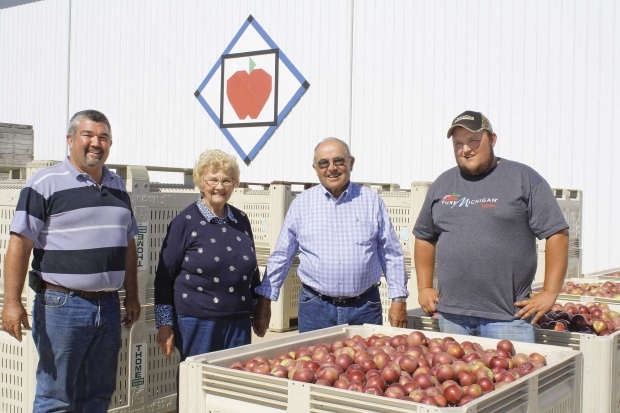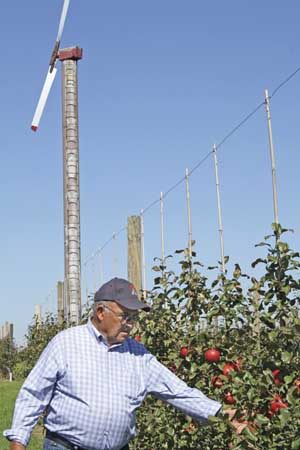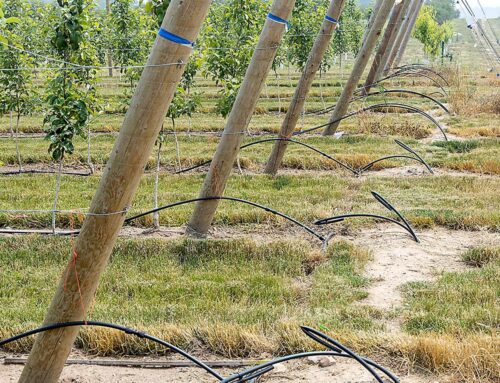
The Thome family poses for a portrait. The new building in the background will house CA storage rooms next year. From left are Steve, JoAnn, Harold, and Mitch. (Richard Lehnert/Good Fruit Grower)
Harold Thome is old enough to remember his dad packing apples into barrels for shipment to Chicago 200 miles away.
But remembering doesn’t make him nostalgic for the old days.
Thome, 82, has a thoroughly modern apple growing operation located on Fruit Ridge near Conklin seven miles north of Grand Rapids, Michigan. He and his wife, JoAnn, farm with their son, Steve, 40, who has taken over management and is gradually buying out his parents’ interest. Steve is bringing in his son, Mitch, 22.
The new building that they will use for controlled-atmosphere (CA) storage next year has the names Harold, Steve, and Mitch emblazoned under the Thome Orchards name.
At the Great Lakes Fruit, Vegetable, and Farm Market Expo in Grand Rapids in December, Harold Thome will receive the Distinguished Service Award from the Michigan State Horticulture Society in recognition of his accomplishments, both in the orchard and as an industry leader.
The 220-acre Thome farm has about 135 acres suitable for apples, and about 125 are in production. “We’re continually removing and replanting, when we can get the trees,” Thome said. “We believe in keeping our orchards young, but trees right now are hard to come by.
We try to stay abreast of new technology and new varieties.”
About a decade ago, the Thomes moved to high-density plantings on two-wire trellis and bamboo stakes. All their plantings since then have been on a 3-by-12-foot spacing. “But we’re still living with our old 6-by-16 spacing on some of our acreage,” he said.
Last year, when Cornell University’s Dr. Terence Robinson wanted to show Fruit Ridge growers his idea for using summer hedging to shear slender spindle trees into fruiting walls, he held his demonstration
on the Thome farm. Hedging was done on a block of five-year-old Brookfield Gala apples.
“Where we hedged last summer, it’s very impressive,” Thome said. “We’re going that way.”

Thome Orchards had one of the earliest plantings of Royal Red Honeycrisp, something found out about traveling with Neal Manly at Willow Drive Nursery on a trip sponsored by International Fruit Tree Association. The wind machine in the backgound is one of seven, an practice he learned about on another IFTA trip. (Richard Lehnert/Good Fruit Grower)
Thome is an early adopter in the sense that he tries new things quickly, but he tests before he plunges too far. He’ll try a few acres of a hot new variety, for example, but he’s cautious about planting more acres until he’s assessed their performance. He’s a believer in finding the right trees for a site.
He planted Honeycrisp about 10 years ago, but has only about three acres now and grumbles about having to stem clip the stems at harvest. He has one of the country’s first plantings of the new Royal Red Honeycrisp from Willow Drive nursery.
But he passed on the opportunity to join Next Big Thing and grow SweeTango. “Both of its parents are ‘problem childs,’” he said, referring to Honeycrisp and Zestar! SweeTango is a very delicate apple and appears very susceptible to russet, he’s learned.
He has one orchard platform from Phil Brown Welding and likes it for thinning and stringing trellis wire. But he doesn’t plan to use it for harvesting—at least, not yet. “I hope I’ll see the time we’re machine-harvesting apples,” he said. “That’s the way we’re designing our orchards.”
Phil Brown Welding is less than two miles away from Thomes, and that’s where the DBR harvester is being developed. Thome shows up at its demonstrations.
The Thome farm has seven wind machines now, added one by one. In the freeze year 2012, when Michigan had less than 10 percent of an apple crop, Thome Orchards had apples near the wind machines, so they proved their worth. “We even had to thin them near the machines,” he said.
“We want to have a crop every year,” he said. Still, he says, one machine can only affect about 10 acres.
Long history
Thome is the fourth generation to own the farm. His great-grandfather emigrated from Germany in 1846 and began growing peaches on the Ridge. It was called Peach Ridge then. After a few years, the farm began shifting to apples, and it’s been that way for more than a century.
Thome and his brother took over the farm and farmed together until a few years back, when they decided to split the farm and create new enterprises that would carry on with their children. The split resulted in some fragmentation of the land, but not much. Harold and Steve have 220 acres now in four blocks, but all within less than a mile of each other. Land not suited to apples is rented out to growers of field crops.
Although his land has been in apples for many years, Thome says he’s found no replant issues. “The soil is quite heavy here, all clay-loam, so we don’t have nematode problems,” he said.
When renovating, they tip the trees with a backhoe, pile them and burn them, roots and all. “We work the land for a couple of years, then replant,” he said.
The Thome farm now grows 13 varieties, newer fresh-market varieties like Gala, Honeycrisp, and an early strain of Fuji (Aztec). “We still grow Red Delicious, and we still plant them,” he said. “But we’re heavy to Gala.”
They also still grow some of the early apple Paulared, which was discovered a half-century ago in an orchard not far from theirs.
They sell their fruit through Jack Brown Produce, which provides storage, grading, and sales services. Next year, however, the Thomes will build CA storage rooms in a large new building.
Thome has an eye for limb and tree mutations. In the 1980s, he found whole-tree mutations of Empire, IdaRed, and Jonathan in his orchards. Those varieties are off patent and declining in popularity now, he said, but the exceptionally red strains he found became commercially successful.
With Galas, which seem to mutate frequently, the tendency seems to be to revert toward yellow and not toward the desirable red. Limbs and whole trees in the Thome Gala blocks show mutations.
Getting educated
Thome refers to himself, and his son and grandson, as “home-schooled,” in that they learned their horticulture while farming rather than in formal education. Steve went to college, but not to the land-grant university and not to study agriculture.
“I think young people need to prove themselves before joining the home farm operation,” Thome said. “Steve worked as a mechanic for a trucking company before coming back home.”
But when Thome says “home-schooled,” it doesn’t mean he stays at home. He and JoAnn are frequent travelers on trips sponsored by the International Fruit Tree Association. Harold joined IFTA in 1959, three years after its founding, and served on its board for 10 years.
“We’ve traveled extensively with IFTA and, really, that’s been my education,” he said. That was where he first saw wind machines in operation, and decided to adopt them. That’s where he first saw high-density apple plantings and adopted that concept. That’s where he found out about Royal Red Honeycrisp and ordered some early.
“My advice to other growers is to get out and be involved with the industry,” Thome said. “See what other growers are doing, locally and all over the world.”
The Thomes have followed Dr. Terence Robinson’s lead in planting in the tall spindle design, using trellises and trickle irrigation, planting well-feathered trees and bending limbs down in the planting year, and using renewal pruning. The next step is hedging them into fruiting walls.
Thome is also a fan of the local Michigan State University extension. Phil Schwallier and Amy Irish-Brown both grew up on Fruit Ridge, became extension educators there, and Schwallier operates an orchard three miles from the Thomes. “They’re very knowledgeable people and a joy to work with,” Thome said. “Extension is like a religion to us.”
Schwallier returns the compliments. “The Thome family sets the bar pretty high for leadership and industry cooperation,” he said. “They’re a pleasure to work with.”
Distinguished service
Over the years, Thome has been recognized for his accomplishments and his service to the industry. In 2010, the Michigan Pomesters named him as their Apple Person of the Year. He’s been president of the pomesters and of the Michigan State Horticulture Society.
JoAnn, who recently retired as the Thome Orchards bookkeeper, is also active in the industry. She was the first woman president of the U.S. Apple Association. Records and payroll for the 20-plus seasonal and three year-round employees at the farm have been handed over to Steve’s wife, Missy.
Thome’s still active on the farm, but cutting back on some things. “This is the first year I haven’t sprayed at all,” he said. “Riding tractor every day just kills my arthritis.” Grandson Mitch does most of that now. •






Congrats Harold and Joann. That is a fantastic article . I found it very interesting. Have a great winter see you at the lake.